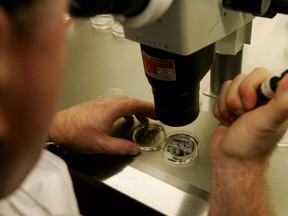Science
Scientists Transform Human Skin Cells into Fertilizable Eggs

Scientists have achieved a groundbreaking feat by successfully transforming human skin cells into fertilizable eggs, marking a significant advancement in reproductive technology. This development, announced on March 6, 2024, is seen as a potential solution for infertility, which affects approximately one in six people globally.
The research team, led by experts from the United States, utilized a technique called in-vitro gametogenesis (IVG) to create viable eggs from skin cells. Though this technology is still years away from being widely accessible, it opens new avenues for individuals and couples facing infertility challenges.
Key Innovations in Fertility Research
Paula Amato, a co-author of the study and researcher at the Oregon Health & Science University, explained the implications of this research. “This technology could allow older women or those who lack eggs for various reasons to genetically reproduce,” she stated. Furthermore, it could enable same-sex couples to have children genetically related to both partners.
The study, published in the journal Nature Communications, follows significant advancements in reproductive science. In July 2023, Japanese researchers created mice with two biological fathers, showcasing the potential of genetic manipulation. However, the current study represents a notable leap forward by employing human DNA.
The process began with the removal of the nucleus from standard skin cells, which were then introduced into a donor egg devoid of its nucleus. This method, known as somatic cell nuclear transfer, was famously used to clone Dolly the sheep in 1996. A critical challenge arose due to the difference in chromosome numbers between skin cells and eggs: skin cells contain 46 chromosomes, while eggs have only 23.
To address this, the team developed a technique they termed “mitomeiosis,” which emulates the natural division of cells. This innovative approach resulted in the creation of 82 developing eggs, or oocytes, which were subsequently fertilized through in vitro fertilization (IVF). After a period of six days, less than nine percent of the embryos reached a stage suitable for transfer to the uterus, a common goal in standard IVF procedures. Despite this low success rate, Amato noted that in natural reproduction, only about one-third of embryos typically reach the viable “blastocyst” stage.
Future Implications and Ethical Considerations
While the results of this study are promising, Amato emphasized that significant hurdles remain. “The biggest challenge is achieving genetically normal eggs with the correct number and complement of chromosomes,” she said. Experts believe that it may take at least a decade before this technology becomes widely available.
Ying Cheong, a reproductive medicine researcher at the University of Southampton in the United Kingdom, praised the findings as “exciting.” She described this as the first demonstration that DNA from ordinary body cells can be successfully incorporated into an egg and activated, prompting it to undergo the necessary chromosomal reduction to form eggs and sperm.
Other researchers are exploring alternative methods to generate eggs, including reprogramming skin cells into induced pluripotent stem cells, which can differentiate into various cell types, including eggs. Amato acknowledged the uncertainty surrounding which technique might prove more successful but reiterated that both approaches face years of further research.
The research adhered to existing ethical guidelines in the United States governing the use of embryos, ensuring adherence to established protocols in this sensitive area of science. As the field of reproductive technology continues to evolve, these advancements hold the potential to redefine the landscape of infertility treatment and family planning.
-

 Politics4 weeks ago
Politics4 weeks agoSecwepemc First Nation Seeks Aboriginal Title Over Kamloops Area
-

 World5 months ago
World5 months agoScientists Unearth Ancient Antarctic Ice to Unlock Climate Secrets
-

 Entertainment5 months ago
Entertainment5 months agoTrump and McCormick to Announce $70 Billion Energy Investments
-

 Science5 months ago
Science5 months agoFour Astronauts Return to Earth After International Space Station Mission
-

 Lifestyle5 months ago
Lifestyle5 months agoTransLink Launches Food Truck Program to Boost Revenue in Vancouver
-

 Technology3 months ago
Technology3 months agoApple Notes Enhances Functionality with Markdown Support in macOS 26
-

 Lifestyle3 months ago
Lifestyle3 months agoManitoba’s Burger Champion Shines Again Amid Dining Innovations
-

 Top Stories2 months ago
Top Stories2 months agoUrgent Update: Fatal Crash on Highway 99 Claims Life of Pitt Meadows Man
-

 Politics4 months ago
Politics4 months agoUkrainian Tennis Star Elina Svitolina Faces Death Threats Online
-

 Sports5 months ago
Sports5 months agoSearch Underway for Missing Hunter Amid Hokkaido Bear Emergency
-

 Politics5 months ago
Politics5 months agoCarney Engages First Nations Leaders at Development Law Summit
-

 Technology5 months ago
Technology5 months agoFrosthaven Launches Early Access on July 31, 2025




















